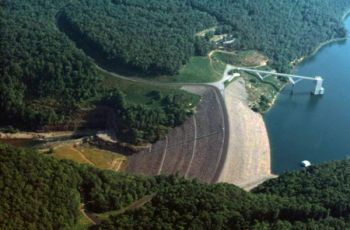Snowmelt

|
| Gathright Dam in Virginia.
(Image Source: Wikipedia) |
“Snowmelt runoff is a major component of the hydrologic cycle in many regions and is an important consideration for water supply and design flood analysis. In some areas, snowmelt event runoff may be more appropriate for the design of water storage facilities and hydraulic structures than rainfall storm runoffs described in National Engineering Handbook (NEH), Section 4 (Part 630), Chapter 10 (USDA SCS 1972a). In addition, the annual peak flow in these areas can arise from either pure snowmelt or rainfall, or a combination of both, leading to a mixed frequency distribution, which is described in the NEH, Part 630, Chapter 18”.[1]
Additional considerations are required for predicting runoff from snowmelt such as measuring snowpack. In the Western United States, the National Resources Conservation Service (NRCS) operates and maintains over 900 SNOTEL (SNOw TELemetry) sites in 11 different states. SNOTEL sites measure “snowpack, precipitation, temperature, and other climatic conditions”.[2] Currently, research is being conducted into the acceleration of snowmelt by different processes such as reduced snow albedo due to dust cover and accelerated snowmelt due to rain-on-snow precipitation events. This research will help to reduce the uncertainty associated with predicting springtime runoff from snowmelt.
Best Practices Resources
![]() National Engineering Handbook: Chapter 11 - Snowmelt, NRCS
National Engineering Handbook: Chapter 11 - Snowmelt, NRCS
Citations:
Revision ID: 7406
Revision Date: 07/21/2023
